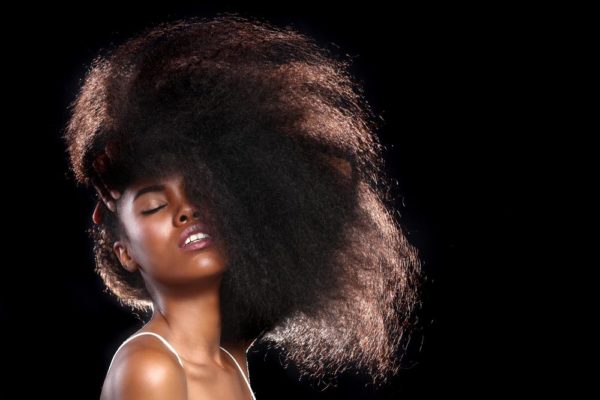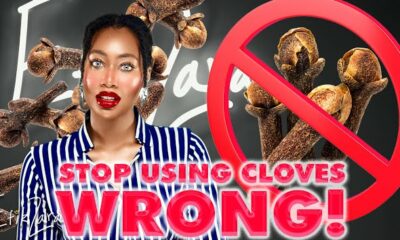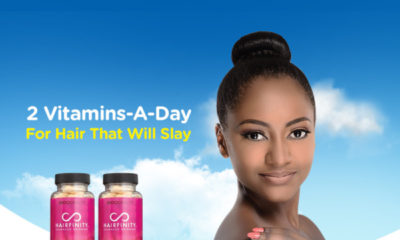Features
Tonkabelle: 5 Reasons Why Your Hair is Not Growing
 First of all before I start writing on this topic I must let you in on the fact that all hair grows. Except for a situation where a person has a medical condition, experiences high stress levels, etc, it is likely that your hair is growing.
First of all before I start writing on this topic I must let you in on the fact that all hair grows. Except for a situation where a person has a medical condition, experiences high stress levels, etc, it is likely that your hair is growing.
Let us think about it – those of us with relaxed/texlaxed hair go in every 2-3 months to get a touch up. If our hair was not growing, there would be no new growth to relax. So the issue is not that our hair does not grow, but rather that when our hair does grow, we are not able to retain the length so our ends break off.
When the ends of your hair break off, this translates to the length of your hair. It may appear that your hair is actually getting shorter or you may end up having the same length of hair for a long period of time. Some of us may find it relatively easy to grow our hair to shoulder length, but growing it anything past that length is where we may struggle. For us to be able to grow our hair long and healthy, it is important that we implement some key changes to how we care for our hair. I will now go on to share 5 reasons why your hair may not appear to be growing and how you can stop this from occurring:
Basic care of your hair is inadequate
It is important that we practice basic hair care to enable our hair grow. Wash your hair with a shampoo. There are mainly two types of shampoos – sulphate shampoos and non-sulcate shampoos. There are several different brands of either kind to choose from. You may also decide to minimise your use of shampoos and to rather wash your hair with conditioners, cleansing conditioners or water-only. It is all about finding out which options work best for you. It is important to deep condition your hair regularly – use moisture and protein deep conditioners as needed. To ensure your hair gets the required moisture it needs, use a good moisturiser or leave-in conditioner daily or less frequently depending on your hair type. It is also very important to seal in the moisture you put into your hair (from the moisturiser, leave-in conditioner) with oil. Experiment with different oils until you find one that works for you. Some people prefer lighter oils, while others tend to use heavier oils. You may, however, decide to switch up your oils according to the weather. You can also do other treatments that would benefit your hair such as oil rinsing, tea rinses, steaming, hot oil treatments, etc.
Another vital tip is to detangle your hair properly/gently. Do not rake a comb through your hair in the name of detangling, as that would only result in breakage. Rather, take your time to detangle in sections – using a hair product that provides a lot of slip to aid the detangling process. It is absolutely crucial to minimise the amount of direct heat you use on your hair, e.g. from curling wands, tongs, flat irons, etc. Such heating tools should be avoided or used very minimally. If possible always air dry your hair. Also curl your hair without heat. However. if you must use heat, apply a heat protectant first.
Finally, protect your hair at night with a silk/satin scarf/bonnet.
Lack of caring for yourself from within
Healthy hair care starts from within. For healthy hair growth and retention of length it is important to be as healthy as possible. Make sure you eat healthy foods from all the food groups in moderate portions. Also be sure to exercise as frequently as possible. Drink a lot of water; this is one of the most important ways to hydrate/moisturise your hair from within. It is similarly important to have as much rest as possible by getting the daily required amount of sleep.
Poor protective styling
A protective style is any hairstyle where our ends are protected and our hair is kept in a particular state over a period of time, thereby decreasing over manipulation. There are two categories of protective styles, the long and short term protective styles. Both categories of hairstyles work well to aid length retention which will consequently result in increased hair growth.
Long term protective styles are hairstyles you leave in your hair for over a week and beyond such as weaves, wigs (that is if you cornrow/braid your hair underneath for at least a week), crotchet braids/twists, braids, twists/braids with our own hair (left in for at least a week), etc.
Short term protective styles are those that are not kept in for a long period of time such as buns, chignons, updos, etc.
When you are able to protective style effectively, you will experience increased hair growth and better length retention. However, there are certain key points to note to ensure that you achieve the maximum benefit possible from your protective style of choice.
Any protective style you get should not be kept in for too long, e.g. any period over 3 months and beyond may result in hair breakage. Protective styles should not be done too tightly and your hair should not be neglected whilst it is in a protective style. Be sure to moisturise it; oil your scalp as well, so that you maintain the health of your hair. You may also to choose to wash/ condition your hair whilst it is in the protective style. This is a matter of personal preference.
Please note that longer term protective styles are an excellent way to give ourselves a break from weekly washing and deep conditioning sessions.
Neglecting the ends of your hair
Our ends are the oldest part of our hair and therefore need to be properly cared for. The main reason why the growth of your hair will usually not translate into increased length is because the ends of your hair keep breaking off. It is, therefore, important that you pay particular attention to your ends.
In everything you are doing as relates to hair care, concentrate your efforts on the ends of your hair. When you are moisturising and sealing be sure to apply moisturiser/oil to your entire hair and the ends in particular. When deep conditioning, coat the ends of your hair with the product as well as the rest of your hair. When detangling your hair ensure that you detangle the ends of your hair as gently as possible.
Also, anyone who has relaxed/texlaxed hair should not apply relaxer to the ends of their hair – as this will result in hair breakage. Typically only the new growth should be relaxed.
Failing to use a growth aid
A growth aid will help to stimulate hair growth and aid length retention. For purposes of this article I am referring mainly to topical growth aids. A growth aid is any product that stimulates hair growth by promoting blood circulation to the scalp and it may also prevent excessive shedding. There are numerous growth aids available, such as Wura’s Secret Hair Growth Oil, Castor Oil, Coconut Oil, etc. The growth aid you choose will depend on your preference and what works for you. Topical growth aids are mainly applied to the scalp.
During application it is important to massage the growth aid into your scalp; this will stimulate the hair follicles which will in turn lead to increased hair growth.
I hope this article helps you figure out why your hair may appear to not be growing. If you would like me to go into more detail on any particular point, I would be glad to do so.
Photo Credit: Katrina Brown | Dreamstime.com
























